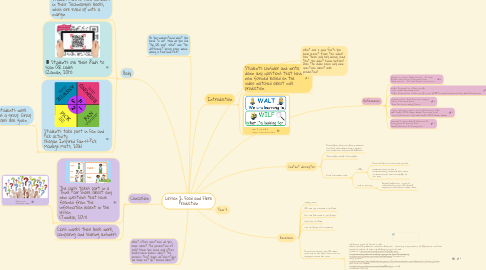
1. Conclusion
1.1. The class takes part in a Think Pair Share about any new questions that have formed from the information learnt in the lesson. (Twinkle, 2017)
1.1.1. Questions: (Churchill, 2015)
1.2. Class marks their book work, comparing and sharing answers.
2. Body
2.1. Students write their answers in their Technologies books, which are ruled up with a margin.
2.2. Students use their iPads to scan QR codes (Zaman, 2017)
2.3. Students take part in Fan and Pick activity (Kagan Inspired Fan-N-Pick Manage Mats, 2016)
2.3.1. Students work as a group. Group roles are given.
3. Do you understand what you have to do? How do you use the QR app? What are the different group roles when doing a Fan and Pick?
4. What other questions do you have about the production of milk? Have you read any other books/seen videos about the process that have details/steps we have not yet heard about?
5. Introduction
5.1. Students consider and write down any questions that have now formed based on the video watched about milk production.
5.2. WALT and WILF (Learn Love Grow, 2017)
6. References:
6.1. Zaman, M. (2017). Quick Scanner - Qr Code Reader and Scanner. Retrieved from Quick Scanner - Qr Code Reader and Scanner
6.2. Kagan Inspired Fan-N-Pick Manage Mats. (2016). Retrieved from Kagan Inspired Fan-N-Pick Manage Mats {FREE Printable} #ClassroomTips #FunInFirstGrade
6.3. Twinkle. (2017). Think Pair Share Display Poster. Retrieved from Think Pair Share Display Poster
6.4. Learn Love Grow. (2017). Learning Intention signs WALT/WILF/TIB *Minion theme*. Retrieved from Learning Intention signs WALT/WILF/TIB *Minion theme*
6.5. Churchill, R. (2015). Asking Questions Is Really Hard. Retrieved from Asking Questions Is Really Hard
7. Content descriptor
7.1. Investigate food and fibre production and food technologies used in modern and traditional societies (ACTDEK012)
7.2. Technologies: Design Technologies
7.3. Cross Curriculum Links
7.3.1. STEM
7.3.1.1. Food and Fibre is a scientific process
7.3.1.2. Students must create a mathematically sequenced flow chart to demonstrate their knowledge of the topic.
7.3.2. Link to literacy
7.3.2.1. Reading different types of informational texts and finding important information within them
8. Year 3
9. Resources
9.1. Sticky notes
9.2. QR code app installed in all iPads
9.3. Fan and Pick cards ( 1 per group)
9.4. Class set of iPads
9.5. List of groups of 4 students.
9.6. Printed out sheets with QR codes that link to the given sites and are displayed around the room:
9.6.1. Different types of farms in WA- Where food is produced in Western Australia - food map | Department of Agriculture and Food Health benefits of milk and different types of milk products: https://www.healthyeating.org/Milk-Dairy https://healthy-kids.com.au/food-nutrition/5-food-groups/dairy/ https://www.youtube.com/watch?v=Q1lDQc0l2jc Features of dairy farms: http://www.dairy.edu.au/discoverdairy/learning-resources/lesson-plans/features-of-dairy-farms How cows are milked: https://www.youtube.com/watch?v=lWFExh_fp7o Living standards of cows: http://agriculture.vic.gov.au/agriculture/livestock/beef/handling-and-management/cattle-shelter-guidelines http://www.legendairy.com.au/dairy-farming/our-farming/a-day-on-the-farm
